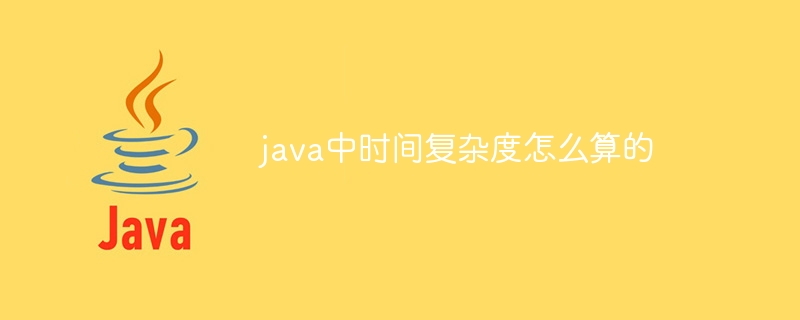How to calculate time complexity in java
Time complexity measures the efficiency of an algorithm and represents the asymptotic behavior of the time required for algorithm execution. Big O notation is used in Java to represent time complexity. Common ones are: O(1), O(n), O(n^2), O(log n). The steps for calculating the time complexity of an algorithm include: determining basic operations, calculating the number of basic operations, summarizing basic operation times, and simplifying expressions. For example, a linear search algorithm that traverses n elements has a time complexity of O(n), and the search time increases linearly as the size of the list grows.

Time complexity calculation method in Java
What is time complexity?
Time complexity is a measure of algorithm efficiency, which describes the time required for an algorithm to execute when the amount of input data is different.
How to calculate time complexity in Java?
Time complexity in Java is usually expressed in big O notation, which represents the asymptotic behavior of a function as the number of inputs approaches infinity. Here are some common time complexity representations:
- O(1): Constant time, the time complexity is constant regardless of the input size.
- O(n): Linear time, the time complexity grows proportionally to the input size n.
- O(n^2): Square time, the time complexity grows proportionally to the square of the input size n.
- O(log n): Logarithmic time, time complexity grows logarithmically with input size n.
How to calculate the time complexity of a specific algorithm?
The steps to calculate the time complexity of a specific algorithm are as follows:
- Identify the basic operations: Identify the basic operations that are performed most frequently in the algorithm.
- Calculate the number of basic operations: Determine the number of times each basic operation is performed for a given input size.
- Summarize basic operation times: Multiply the time complexity of each basic operation by the number of times it is executed, and add them together.
- Simplify the expression: Eliminate the constant factors and retain the highest order term related to the input size.
Example:
Consider the following linear search algorithm for finding elements in a list:
public int linearSearch(List<Integer> list, int target) {
for (int i = 0; i < list.size(); i++) {
if (list.get(i) == target) {
return i;
}
}
return -1;
}- Basic operations: Traverse each element in the list.
- Number of basic operations: n, where n is the size of the list.
- Summary basic operation time: n * 1 = n
- Simplified expression: The time complexity is O(n).
Therefore, the time complexity of this linear search algorithm is O(n), which means that as the list size grows, the time required for searching will increase linearly.
The above is the detailed content of How to calculate time complexity in java. For more information, please follow other related articles on the PHP Chinese website!

Hot AI Tools

Undresser.AI Undress
AI-powered app for creating realistic nude photos

AI Clothes Remover
Online AI tool for removing clothes from photos.

Undress AI Tool
Undress images for free

Clothoff.io
AI clothes remover

AI Hentai Generator
Generate AI Hentai for free.

Hot Article

Hot Tools

Notepad++7.3.1
Easy-to-use and free code editor

SublimeText3 Chinese version
Chinese version, very easy to use

Zend Studio 13.0.1
Powerful PHP integrated development environment

Dreamweaver CS6
Visual web development tools

SublimeText3 Mac version
God-level code editing software (SublimeText3)

Hot Topics
 1381
1381
 52
52
 How does Java's classloading mechanism work, including different classloaders and their delegation models?
Mar 17, 2025 pm 05:35 PM
How does Java's classloading mechanism work, including different classloaders and their delegation models?
Mar 17, 2025 pm 05:35 PM
Java's classloading involves loading, linking, and initializing classes using a hierarchical system with Bootstrap, Extension, and Application classloaders. The parent delegation model ensures core classes are loaded first, affecting custom class loa
 How do I implement multi-level caching in Java applications using libraries like Caffeine or Guava Cache?
Mar 17, 2025 pm 05:44 PM
How do I implement multi-level caching in Java applications using libraries like Caffeine or Guava Cache?
Mar 17, 2025 pm 05:44 PM
The article discusses implementing multi-level caching in Java using Caffeine and Guava Cache to enhance application performance. It covers setup, integration, and performance benefits, along with configuration and eviction policy management best pra
 How can I use JPA (Java Persistence API) for object-relational mapping with advanced features like caching and lazy loading?
Mar 17, 2025 pm 05:43 PM
How can I use JPA (Java Persistence API) for object-relational mapping with advanced features like caching and lazy loading?
Mar 17, 2025 pm 05:43 PM
The article discusses using JPA for object-relational mapping with advanced features like caching and lazy loading. It covers setup, entity mapping, and best practices for optimizing performance while highlighting potential pitfalls.[159 characters]
 How do I use Maven or Gradle for advanced Java project management, build automation, and dependency resolution?
Mar 17, 2025 pm 05:46 PM
How do I use Maven or Gradle for advanced Java project management, build automation, and dependency resolution?
Mar 17, 2025 pm 05:46 PM
The article discusses using Maven and Gradle for Java project management, build automation, and dependency resolution, comparing their approaches and optimization strategies.
 How do I create and use custom Java libraries (JAR files) with proper versioning and dependency management?
Mar 17, 2025 pm 05:45 PM
How do I create and use custom Java libraries (JAR files) with proper versioning and dependency management?
Mar 17, 2025 pm 05:45 PM
The article discusses creating and using custom Java libraries (JAR files) with proper versioning and dependency management, using tools like Maven and Gradle.




